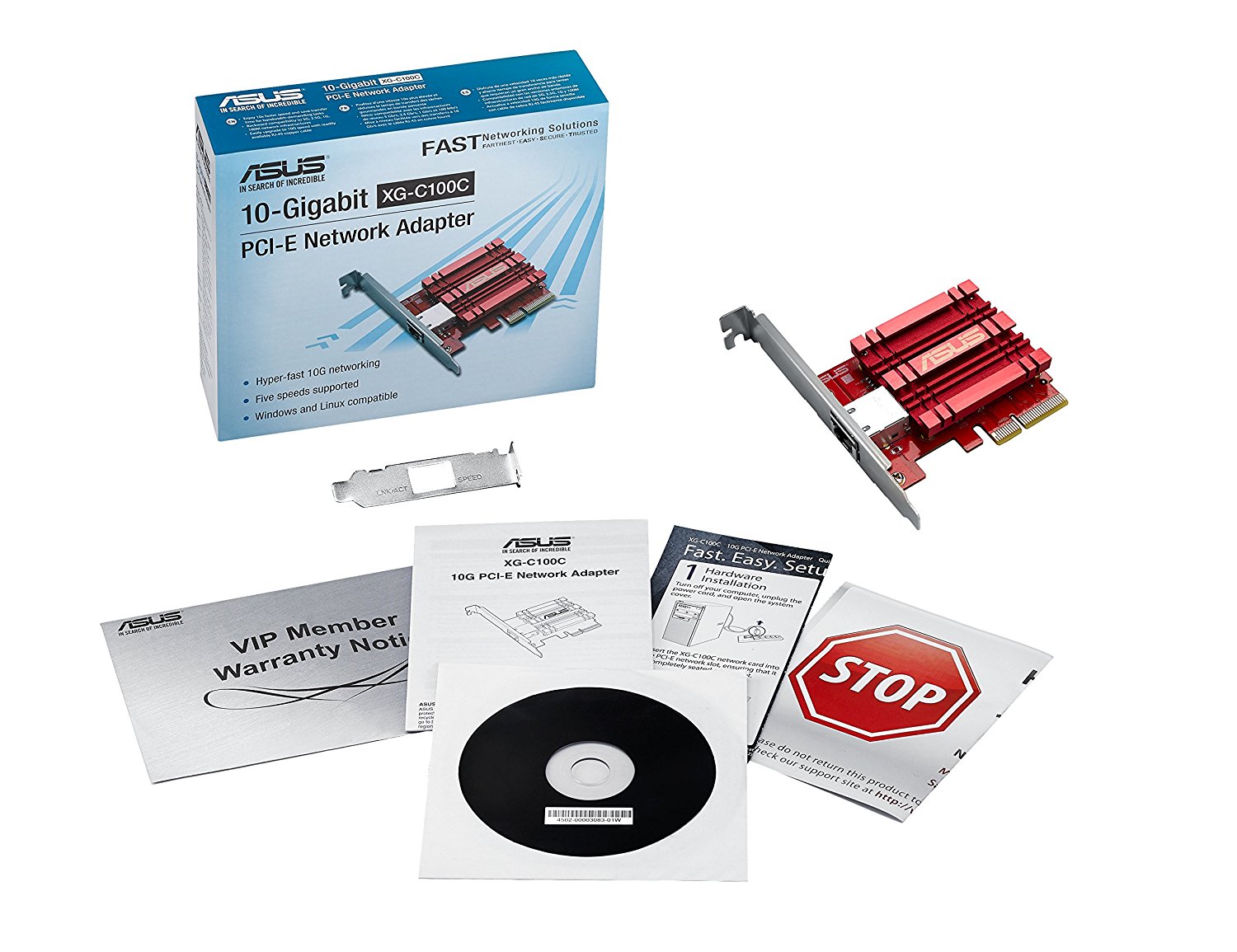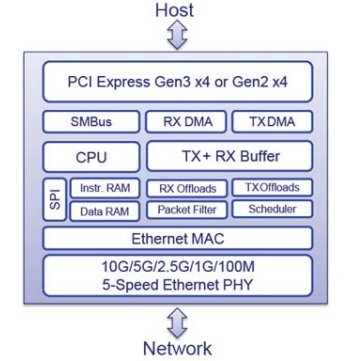Asus Releases XG-C100C 10GBASE-T NIC For $99 (Updated)
Update, 6/28/17, 8:50am PT: Asus officially announced the XG-C100C's release in North America. The company said the NIC is now available from "leading resellers" with the $100 MSRP we previously reported. Amazon still doesn't seem to have the card in stock--it's currently only available from a third-party seller--but Newegg does.
Original article: 6/21/17, 10:00am PT:
Asus rounded out the branded 10GbE ecosystem today with a desktop add-in network interface card to go with the previously released XG-U2008 unmanaged switch ($250 on Amazon). For less than $100 you get massive bandwidth with priority queuing for enhanced gaming support.
10GbE delivers just over 1,000MBps, which is just what you need to take advantage of your new NVMe protocol SSD across the network. The market is ready for a network upgrade, but we need products like the new XG-100C NIC and motherboards with the feature onboard to jump start demand, according to industry insiders.
The XG-C100C supports 10GbE and the latest 2.5 and 5GbE standards. The lower bandwidth standards have yet to appear in a home-focused switch, but when they're available, they'll allow you to use legacy CAT5e cabling to avoid the expense of running new wire throughout your home. In our testing, we've found that users can still use CAT5e to achieve 10GbE speeds for short distances.
IEEE 802.1p Priority Queuing is a supported feature on the XG-C100C, and it allows users to utilize Quality-of-Service (QoS) technology. This allows you to prioritize game packets over other traffic, for example, to help make sure you experience smooth gameplay even if you're using your network for other things at the same time.
The NIC will set your system back four PCI Express 3.0 lanes as required by the Aquantia AQtion Client Controller. There are two specifications that make this product stand out from other 10GbE NICs shipping today. The first is the low $99 price tag. Amazon already has a product page for the XG-C100C, but doesn't have stock at time of writing. The MSRP is low and we expect pricing to get better over time. The second standout feature is related to why the market has adopted the AQtion AQC107 controller: it consumes very little power, and thus produces very little heat. The products we've seen use a low-cost heat sink--or no heat sink at all, in the case on onboard designs. Both features run contrary to enterprise-focused products, which are expensive and require cooling beyond what most of us use in our quiet desktops.
Get Tom's Hardware's best news and in-depth reviews, straight to your inbox.
The question many will ask is: What the hell do you do with 1,000MBps of network bandwidth? If you have to ask, then this might not be the upgrade for you. More products will support the 10GbE and Multi-Gigabit standards in time. Wouldn't it be nice to watch a high-definition movie from across the network without stuttering? 10GbE ships on nearly all of the latest network-attached storage appliances costing north of $450. Just like USB 3.1 Gen 2, Thunderbolt 3, and NVMe, 10GbE enhances storage bandwidth, and that's what you need to increase before life-like gameplay can become a reality. Until then, you will just have to live with very fast file transfers and lower latency.
| Product | Asus XG-C100C |
|---|---|
| Chipset | Aquantia AQtion AQC107 Client Controller |
| Port Attributes | RJ-45 100Mbps, 1Gbps, 2.5Gbps, 5Gbps/10GbpsAuto-Negotiation |
| Standards | IEEE 802.3an 10GBASE-TIEEE 802.3u 100Base-TX Fast EthernetIEEE 802ab 1000Base-T Gigabit EthernetIEEE 802az Energy Efficient EthernetIEEE 802.1p Priority Queuing |
| Performance | Jumbo Frame Support: 9 KB |

Chris Ramseyer was a senior contributing editor for Tom's Hardware. He tested and reviewed consumer storage.
-
extremepenguin I will be happier when I start seeing 10GB ports on laptops and more importantly WAP's. Any machine that I have needed 10GB on I already have SFP+, don't get me wrong this is a step in the right direction but after you factor in the cost of a switch that has 10 GBE ports on it I am pretty sure fiber come in ahead on price.Reply -
Snipergod87 That is actually pretty expensive, you can get older used server 10Gbit SFP+ NICS for less than $20Reply -
artk2219 Reply19846198 said:That is actually pretty expensive, you can get older used server 10Gbit SFP+ NICS for less than $20
True, but then you still need an SFP+ switch or transceiver which is another cost, unless you already have the infrastructure in place. Also you have to make sure that they are not SFP+ direct attach only cards if you are looking to use a transceiver. -
How much watts does this require? I've seen one 10G nic that used 12.5W, another that needed 100W. These things seem to be all over the place in terms of power requirement. Meanwhile, if an EPYC CPU can have 128 PCIe lanes and be under 150W, then why are these nics so power hungry? Is there some sort of PoE requirement in the standard? Can this card do PoE? It's not listed.Reply
-
bit_user Reply
The ones I see are PCIe x8, and most enthusiasts don't have spare x8 slots to burn on this, unless they drop their GPU down to x8. That seems like an unnecessary compromise, even if it's not a big performance hit.19846198 said:That is actually pretty expensive, you can get older used server 10Gbit SFP+ NICS for less than $20
Then, as has been pointed out, you need to add the cost of the transceivers, unless you're going to be limited to the < 5m supported by SFP+ copper cables.
Common sense should tell you that $20 for 10 Gig is too good to be true. It's only that cheap due to caveats. -
bit_user Reply
No.19846141 said:I will be happier when I start seeing 10GB ports on laptops
Mobile workstations, perhaps. Maybe a couple of the chunkier gaming laptops.
I'm pretty sure it won't.19846141 said:after you factor in the cost of a switch that has 10 GBE ports on it I am pretty sure fiber come in ahead on price. -
bit_user Reply
Source? That's got to be a typo - should be 10 W.19846880 said:I've seen one 10G nic that used 12.5W, another that needed 100W.
-
Reply19847084 said:
Source? That's got to be a typo - should be 10 W.19846880 said:I've seen one 10G nic that used 12.5W, another that needed 100W.
Not a typo. Don't have a source. Might have been a dual nic, but I remember it being over 100 Watts, and in the $1500 range. Enterprise stuff, not consumer. I'm not imagining it either, because I remember thinking how insane that was, but can't find it now. It "might" have had PoE. -
bit_user Reply
Well, we need more specifics to draw any kind of insight from it.19847148 said:19847084 said:
Source? That's got to be a typo - should be 10 W.19846880 said:I've seen one 10G nic that used 12.5W, another that needed 100W.
Not a typo. Don't have a source. Might have been a dual nic, but I remember it being over 100 Watts, and in the $1500 range. Enterprise stuff, not consumer. I'm not imagining it either, because I remember thinking how insane that was, but can't find it now. It "might" have had PoE.

